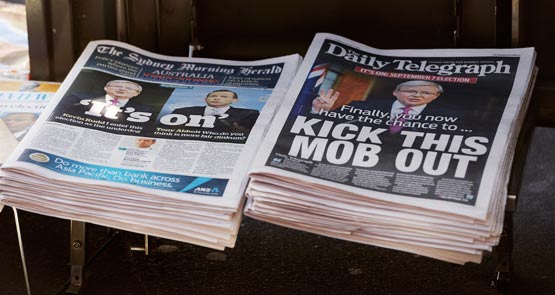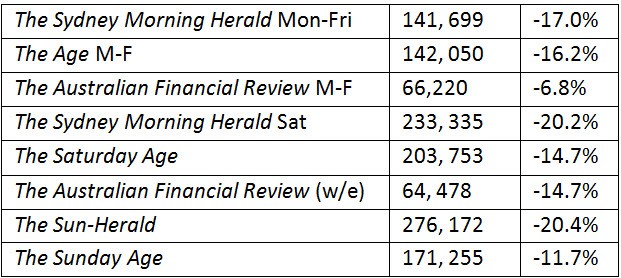
The latest newspaper circulation results offer a grim reality check for both Fairfax and News Corporation Australia. Fairfax’s metropolitan papers continue to bleed sales, despite the shift to commuter-friendly compact formats. News’ biggest-selling papers recorded unprecedented double-digit circulation drops year-on-year. And monopoly status is offering no protection for regional papers, which are rivalling their big-city brethren for circulation declines.
How strange it is to remember Australian papers were holding relatively steady only three years ago, bucking the downward trend in the US. Now we’ve reached the point of contagion: total newspaper circulation slumped by 11.2% year-on-year in the June quarter, with no papers picking up paid sales.
The industry has responded to the results with a mixture of silence and what looks like magical thinking. News Corp kept schtum on the figures; so did industry group The Newspaper Works, which will no longer comment on print-only data. News and Newspaper Works are hyping the Monday arrival of new cross-platform readership measure emma (Enhanced Media Metrics Australia), which has been developed for the industry by Ipsos Australia. Some advertisers may wonder about paying the piper to call the tune, but that’d be too cynical, wouldn’t it?
The Australian reports the figures today under the overly optimistic headline “Digital news surge offsets print’s decline”. There’s no doubt the Oz‘s digital subscription model is performing strongly with 51,213 sales — up from 45,869 last quarter. But otherwise there’s little to crow about, with the country’s top-selling paper, the Herald Sun, recording a meagre 30,624 digital sales for the quarter. And in private Fairfax big-wigs aren’t doing cartwheels about the money coming in from The Age and The Sydney Morning Herald metered paywalls. The next survey will give better insights into how News and Fairfax’s paywall strategies are faring.
In the land of the dead trees, Fairfax Media recorded another poor quarter. The weekday Sydney Morning Herald was down 17% year-on-year to 141,699 and is now outsold by southern sibling The Age, which fell by 16.2% on weekdays to 142,050. The Saturday SMH (once overflowing with classified ads) slumped by 20.2% to 233,335; The Saturday Age fell by 14.7% to 203, 753. The SMH and The Age also shed copies quarter-on-quarter, showing any circ boost from the shift to compact was shortlived. Perennial under-performer The Sun-Herald fell by 20.4% and The Sunday Age slipped by 11.7%.
The Australian Financial Review fell by 6.8% to 66,220 on weekdays and by 14.7% on Saturdays (reversing an anomalous jump in the previous quarter).
Circulation for Fairfax’s regional papers also plummeted: The Canberra Times fell by 8.4% Mon-Fri to 26,153, The Newcastle Herald by 11.5% to 36,368 and The Illawarra Mercury by 15.7% to 18,229. Here are the average daily print circulation figures for the June quarter, compared to the same quarter for the previous year:

It was almost as demoralising at News Corp: no wonder Col Allan has been shipped back from New York to wave his supposedly magic wand. The Australian fell by 9.8% on weekdays year-on-year to 116,655; The Weekend Oz slumped by 10.8% to 254,891. A full 19% of the Oz’s sales are still in the accommodation, airline, education or bundled categories (compared to 13% at the AFR).
Sydney’s The Daily Telegraph posted its first double-digit year-on-year declines: the Tele fell by 11.2% on weekdays to 310,724 and by 10.6% on Saturdays. The Sunday Telegraph shed 11.2% to 541,749 a week. It was almost as ugly in Melbourne, where the Herald Sun dropped by 10.3% on weekdays to 416, 027. On Sundays the Hun was down 8.2%.
Brisbane’s Courier-Mail declined by 8.8% to 173,095 Monday to Friday while Adelaide’s The Advertiser slipped by 10% to 155,635. The Hobart Mercury was down 7% to 37,419. Seven West Media‘s West Australian was down by 8.7% on weekdays to 178,385 and by 3.8% on Saturdays. Here are the News Corp circulation figures:

Unlike in newspapers, you can find some winners among the normally blighted magazine sector. At least 15 magazines saw their sales rise in the year to June, with the home, garden and lifestyle sectors leading the way. News Corp’s NewsLife Media stable performed well, seeming to vindicate ousted CEO Kim Williams’ decision to put Nicole Sheffield in charge. NewsLifeMedia’s Vogue rose 0.4%, Vogue Living rose 1.8%, Delicious rose 5%, Country Style sold 1.5% more copies and Inside Out lifted its sales by 1.4%. Fairfax’s BRW had a nasty drop: 17.4% to only 33,900.
Among the big sellers though the news was gloomy, except for Australian Women’s Weekly (Bauer) which saw sales slip just 1.4% to 459,175. Woman’s Day (Bauer) lost 4.2% and Pacific Mags’ New Idea shed 4.4%. Other notable falls included 17%-plus plunges by Bauer’s Dolly and Cosmopolitan and a 25.9% decline for struggling lads’ mag Zoo Weekly. Craft and culture magazine Frankie was again a standout performer, posting a 10.7% jump to 64,931.
*Additional reporting by Glenn Dyer







The death spiral continues.
BTW It would be nice to know how Crikey’s going.
It would also be interesting to check the numbers over the election period to see if there has been any change in the figures (print and online) particularly given News hard run against the government.
“there’s a few magazines which are holding their own”
there are
There’s not enough proofreading at Crikey
Maybe there are not enough proofreaders 🙂
Frankly, I’m over it. The sooner the dead tree media are gone, the better. Your lead pic speaks volumes for the impartiality of the Murdochracy.
I am sure that the Coalition and the Murdochracy will find a way to saturate the on-line media with their propaganda, though it will take some time for that to kick in, so in the mean time I will enjoy the ability to read and learn what I want.
The sooner the trend focus’s towards zero the better we will be. The rubbish journalism with the odium of a garbage can and now News has the cheek to raise the price by 10%. News Ltd is now aversion – to be avoided at all costs.